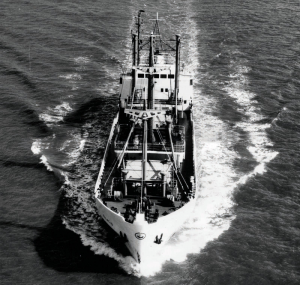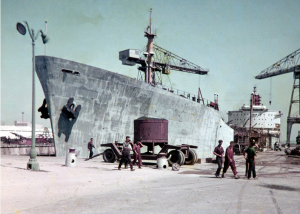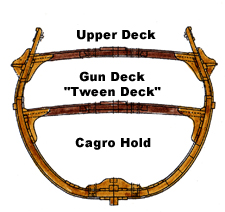Article written by George Hoyle (Malaysia) Special thank you to the Editorial Manager, Steve Robinson of Sea Breezes Publications Ltd.
Catch up on Part 1 or 2 if you’ve missed it previously.
Part 3 – The many the vessels George Hoyle worked on
POZARICA: Built 1941, by Gebr Pot, Bolnes South Holland 2,514 GRT, 3,017 DWT (Ex Hermes, Ex Empire Dove, Renamed Pozarica in 1953). She was a former War Prize. Speed 15 knots, 12 Passengers, 4 hatches/4 holds, Engine room amidships. It was rumoured that the chief mate’s cabin and cargo office on the starboard side were to have been for the Gestapo officer that would have been assigned to the ship, but she never sailed as such, having been captured by the allies in Holland, before she had completed construction. So I don’t know how true that story was, although it was a topic of conversation when passengers were on board. I have kept a copy of the Pozarica’s brochure for the London-Lisbon Service, which was a super trade to be on. Five days discharge/load in London, four days at sea, London-Lisbon, (sometimes Portimao as well), five days in Lisbon discharge/load, four days at sea then back to London.
A good schedule for both passengers and crew alike. The trade in cargo at that time (before widespread containerisation came in) was General Cargo outwards, including transhipment cargo for Angola and other Portuguese African destinations were transhipped at Lisbon. General cargo was mostly larger manufactured goods, including vehicles, farming machinery, ex London buses, bales and casework of goods and bales of rags etc. There were also some live animals such as dogs, who immediately became friends of the crew. I always took them into my cabin to stay, rather than leave them out on the boat deck in kennels to suffer the bad weather. It was, of course, a source of income for us (but you wouldn’t get rich on it). We used to exercise them and ourselves by walking the decks each day, ourselves or the bosun collecting their droppings and hosing down the decks. After a six month tour of duty on the Pozzie I was promoted to Chief Mate of the Villegas.
VILLEGAS: Built 1955, Rolandwerft gmbh Bremen, 1,216 GRT 1,605DWT, speed 14 knots Twin MWM engines, single screw, Engine Room Aft. I spent two trips on her from Liverpool-Spain-Liverpool. On the 2nd trip, the Commercial Manager, Mr Arthur White (aka Chalky) from the Liverpool Office, came with us for one trip to familiarize himself with the ship and visit the station managers at each port. We became good friends and kept in touch for many years after I came ashore in December 1964. On the first round trip, I saw my first ship, the Warwick Castle, being broken up on the breakwater berth in Barcelona. It brought back memories. My next ship as Chief Mate was the Velarde.
VELARDE: Built 1957, by Ottensener Eisenwerk, Hamburg 2,055 GRT, about 2750 DWT, Speed 16 knots Twin MAN Engines, single screw, midships engine room. Three Hatches/ Three Holds 12 Passengers, Reefer space. 30 Tons heavy lift Derrick. I joined her in London and, to my surprise, the Master was Mike Dunn. Sailing from London, we headed direct to Casablanca to discharge and, as the cargo for the next port Gibraltar consiste of Naafi (Navy, Army & Air Force Institution) goods for the troops on the rock, there was a high risk of pilfering. I overcame that by putting our Polish crew, on overtime as volunteers to go into the holds to keep the pilfering at bay. It worked. We arrived in Gibraltar with minimum losses. The MacAndrew station manager in Gibraltar said he was amazed to see such little damage. He was expecting to see the holds strewn with damaged cargo. We also had some reefer cargo to discharge as well. Onto the next two ports of call on the Spanish coast, San Feliu and Palamos. Both near the French border, very pleasant little tourist/seaside ports where it took us all day to load just 60 tons of cork bales, cases of champagne and bags of almonds etc. The main form of transport to the ship’s side were donkey carts. Then onto Barcelona and Valencia to pick up homeward bound cargo, before proceeding back to London. That was a nice and easy trade on a lovely ship. I was then transferred to be the Chief Mate of the Palacio in London.
 PALACIO: Built 1961, by Krogerwerft, Rensburg, Germany 1,096 GRT, 1,461 DWT, Speed 14 knots nine Cylinder MAN engine, single screw. Engine room aft, three Hatches, three Holds. The crew consisted of Captain Alec Beeves and Captain John Rimmington, 2nd Mate Mike Theocolous and 3rd Mate Ronnie Warwick, who later followed in his father’s footsteps to become the Master of the Queen Elizabeth 2 (Cunard passenger liner). The trading pattern was the same as her sister ship Pacheco, except that we loaded bulk wine every trip by calling at Tarragona.
PALACIO: Built 1961, by Krogerwerft, Rensburg, Germany 1,096 GRT, 1,461 DWT, Speed 14 knots nine Cylinder MAN engine, single screw. Engine room aft, three Hatches, three Holds. The crew consisted of Captain Alec Beeves and Captain John Rimmington, 2nd Mate Mike Theocolous and 3rd Mate Ronnie Warwick, who later followed in his father’s footsteps to become the Master of the Queen Elizabeth 2 (Cunard passenger liner). The trading pattern was the same as her sister ship Pacheco, except that we loaded bulk wine every trip by calling at Tarragona.
Meanwhile, I had severely curtailed the amount of overtime the deck crew were getting every voyage from cleaning and painting the bulk wine tanks. The practice had been to immediately wash out the tanks with fresh water after discharging the bulk wine into the PLA’s Vats at Shadwell basin. The wine and water admixture would go into the pumproom bilges, before being pumped out at sea once we were clear of the outward London river pilot. The red wines, in particular, would stain the paintwork of the tanks if they were not washed out immediately. Then quickly drying the tanks out thoroughly next day before starting on the extensive painting programme of all of the tanks. One man per tank would then emery cloth down to the bare metal of all of the small pinholes of rust/breakdown of the epoxy resin surface, prime it and then apply two topcoats of white gloss epoxy resin paint to the whole surface area of the tank. Then immediately, prior to arrival at Tarragona, all the tanks were fumigated with sulphur buttons and all hose couplings oiled with olive oil. I did not think it was necessary to keep applying coats of expensive gloss white epoxy resin paint. It was used normally in its two pack form for painting yachts. To those areas of each tank which did not have any breakdown of coating or signs of rust I, instead, instigated a programme of only wholly painting about 25% of the tanks during each outward voyage to Tarragona as well as those areas of other tanks which had suffered breakdown.
Also I had observed, whilst on the Pacheco, that it was the tanks that had previously contained dry red wines (higher acid content) that had the most breakdown of the coatings. So I decided to concentrate more on those for total repainting and, of course, any other tanks that had suffered any coating damage. It worked; the appearance of all tanks upon arrival at Tarragona each voyage, was still clean and sparkling shiny paintwork in all tanks. Of course, I wasn’t popular with the crew. Palacio was a very good little ship and I thoroughly enjoyed my time on board, better still when Captain Rimmington was in command for about three months.
POZARICA: As Chief Mate January- June 1964. Initially with Capt John Rimmington as Master, then Capt AW Loudon. Chief Engineer Freddy Fox. 3rd Mate Chris French (later to become a Pilot at GT Yarmouth) and Jim Smith as 2rd Mate, (later to become a Master of an offshore Supply vessel that I managed for offshore North Sea).
Down the hatch

Keith Innes (Aberdonian) a 2nd Mate that succeeded Jim Smith, was a very good friend too and we met up again in Saudi Arabia in 1987. He was a Port Operations Consultant to the Saudi Seaports Authority in Dammam. I was then a project manager in King Fahd Industrial Port Yanbu (on the red sea coast). One little dog regularly liked to leap up onto the hatch cover at No 3 hatch for a quick rollover and scratch of the tarpaulin covers (old type ship with wooden hatch covers and three sheets of tarpaulin and locking bars). One day when we were at anchoroff Portimao, we had the hatch open discharging/loading cargo. When Keith walked by, she leapt onto the non existent hatch cover and fell straight into the tween deck, much to the surprise of the stevedores in the tween deck. Keith literally flew down the access ladder to the tween deck, felt her all over for broken bones etc and retrieved our “investment” safely. Sighs of relief all round. Homeward bound cargoes from Portugal, at that time, were large amounts of drums of resin, bales of cork, barrels and cases of wines, fruits, bags of almonds and olive oil in drums and cases. There were also some general cargo; light vehicles and cases of tinned sardines from Portimao and for Lisbon. Cork was a big product of the Alantejo district of Portugal, they even made furniture from it.
Captain John Rimmington was the Master for my first two tours of duty on Pozarica and we became good friends. I also sailed with him later when I was Chief Mate of the Palacio. Sadly he died a few years ago, aged 90. John was very popular with the passengers, he knew all the places in Lisbon, Portimao, Cadiz and Seville for sightseeing, entertainment, food, shopping and wines. I always remember being ashore one evening when on Pozarica in Seville, where, after enjoying some tapas and a couple of good sherries, we went onto visit the well known Goya Hierro (excuse my spelling) to see Flamenco dancing. The food was good and the show was excellent; the atmosphere was incredibly vibrant. John was also an ex tanker master from Shell tankers in the Far East. He was a character larger than life, he loved the Pozarica. She was his ship, he even used to unfurl a large MacAndrew house flag every day in the garden of his Suffolk retirement home.
Continuing as Chief Mate of the Pozzie after John went on leave and Captain Arthur Watson Loudon joined. Freddy Fox was the Chief Engineer. I think he later went on to write some books and to live in Spain. Shortly after five voyages, she was sold and upon my birthday in Lisbon, I had a party on board with fellow ship’s officers and a few friends from the British Embassy. Knowing the ship was being sold, we made a present of a spare bell to the social club of the Embassy, so if you ever visit that club you may see the bell there. It has a distinctive crack in it which I had temporarily repaired some voyages earlier, by the simple expedient of getting our Latvian carpenter to drill a hole at each end of the crack. It worked. I was the last officer on the Pozarica, when she was handed over to the Spanish buyers in Millwall drydock, East London. She had drydocked for a pre-sale inspection in June 1964. Her name was changed to Bluefin and she was registered under the Panamanian Flag. It was, with some sadness, that I read in Lloyds List some 17 months later (dated 29 Nov 1965), that the Bluefin (Ex Pozarica) had sunk in the Bay Of Biscay at 16:50 GMT on 27th November 1965 in position 46 deg 20 mins North long 03 deg, 25 minutes West, in a storm after losing her rudder and experiencing a shift of her cargo of iron ingots by broaching to.
PALOMARES: Built 1963 by Grangemouth Dockyard Co, Ltd, Grangemouth, Scotland, 1,200 GRT, 1600 DWT, Speed 14 knots, eight Cylinder National Gas & Oil Engine Co, Single screw, Engine room aft, three Hatches/ three Holds, bulk Table wine tanks. Sister ship to the Pacheco and Palacio. Captain AW Loudon, Captain Mike Rosher and 2nd Mate Keith Innes, then took over from me when I resigned early. Same trade as her sisters, her last cargo was a full cargo of oranges to Bristol from Valencia where I left the ship and the sea for good, or so I thought at the time. I had married a year before in December 1963, and even one year’s separation by being at sea most of the time was enough for me. So I resigned and came ashore and got an immediate job in ship management with Caltex tankers at Knightsbridge in London, operating up to 20 tankers, trading worldwide from product carriers to supertankers carrying crude oil. My favourite ships were of course the Pozarica (twice), Velarde and Palacio.
If anyone had to go to sea for a living, earn some money and see some interesting places, this was the type of company to be with. With a long tradition and small, but fast ships and frequent trips home with regular leave etc. But sadly containerisation has sounded their death knell.


